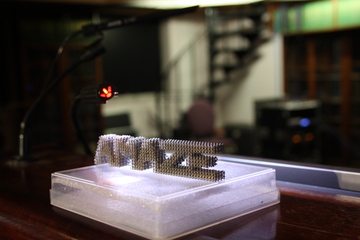Astronauts may soon be able to craft their own tools while up in space, thanks to a new initiative by the European Space Agency created to refine 3D-printing techniques. The project is called AMAZE, short for Additive Manufacturing Aiming Towards Zero Waste. Officials are optimistic about the effects advances in 3D printing could have not just for space technology, but areas such as aircraft and automobile development as well.
Examples of the techniques AMAZE seeks to expand upon were shown in the London Science Museum on October 15. International experts showed off objects created by metal 3D printing such as the one below, and explained how the additive manufacturing technique of 3D printing—which builds an object by printing a series of layers, most often of melting powder or wire, one on top of the other—allowed them to produce complex objects with much less material wasted and much more flexibility than the techniques used in traditional manufacturing.

3D metal printing at the London Science Museum
Together with the European Union, the ESA aims to fine-tune 3D printing enough to make space-grade metal parts and to inspire innovations that could lead to astronauts crafting their own tools aboard the International Space Station.
With 28 industrial partners across Europe, AMAZE is currently considered the world’s largest metal 3D printing project. According to David Jarvis, the ESA’s Head of New Materials and Energy Research, the AMAZE group is focusing on creating space-quality objects through lasers, electron beams, and plasma that could melt metal alloys. AMAZE is also exploring the uses of lightweight metals such as tungsten, niobium, and platinum.
Four 3D printing factories are currently being established in Germany, Italy, Norway, and the United Kingdom as part of the initiative. AMAZE could eventually allow astronauts to print their own metal tools, or even allow engineers to print entire satellites using these techniques.
Source Space.com
Advertisement





